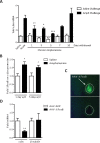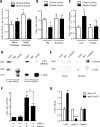Delta FosB mediates epigenetic desensitization of the c-fos gene after chronic amphetamine exposure
- PMID: 18632938
- PMCID: PMC2610249
- DOI: 10.1523/JNEUROSCI.1043-08.2008
Delta FosB mediates epigenetic desensitization of the c-fos gene after chronic amphetamine exposure
Abstract
The molecular mechanisms underlying the transition from recreational drug use to chronic addiction remain poorly understood. One molecule implicated in this process is DeltaFosB, a transcription factor that accumulates in striatum after repeated drug exposure and mediates sensitized behavioral responses to psychostimulants and other drugs of abuse. The downstream transcriptional mechanisms by which DeltaFosB regulates drug-induced behaviors are incompletely understood. We reported previously the chromatin remodeling mechanisms by which DeltaFosB activates the expression of certain genes; however, the mechanisms underlying DeltaFosB-mediated gene repression remain unknown. Here, we identify c-fos, an immediate early gene rapidly induced in striatum after acute psychostimulant exposure, as a novel downstream target that is repressed chronically by DeltaFosB. We show that accumulation of DeltaFosB in striatum after chronic amphetamine treatment desensitizes c-fos mRNA induction to a subsequent drug dose. DeltaFosB desensitizes c-fos expression by recruiting histone deacetylase 1 (HDAC1) to the c-fos gene promoter, which, in turn, deacetylates surrounding histones and attenuates gene activity. Accordingly, local knock-out of HDAC1 in striatum abolishes amphetamine-induced desensitization of the c-fos gene. In concert, chronic amphetamine increases histone H3 methylation on the c-fos promoter, a chromatin modification also known to repress gene activity, as well as expression levels of the H3 histone methyltransferase, KMT1A (lysine methyltransferase 1A, formerly SUV39H1). This study reveals a novel epigenetic pathway through which DeltaFosB mediates distinct transcriptional programs that may ultimately alter behavioral plasticity to chronic amphetamine exposure.
Figures



Similar articles
-
Epigenetic Regulation of Hippocampal Fosb Expression Controls Behavioral Responses to Cocaine.J Neurosci. 2019 Oct 16;39(42):8305-8314. doi: 10.1523/JNEUROSCI.0800-19.2019. Epub 2019 Sep 2. J Neurosci. 2019. PMID: 31477569 Free PMC article.
-
Chromatin remodeling is a key mechanism underlying cocaine-induced plasticity in striatum.Neuron. 2005 Oct 20;48(2):303-14. doi: 10.1016/j.neuron.2005.09.023. Neuron. 2005. PMID: 16242410
-
Regulation of fosB and DeltafosB mRNA expression: in vivo and in vitro studies.Brain Res. 2007 Apr 27;1143:22-33. doi: 10.1016/j.brainres.2007.01.069. Epub 2007 Jan 27. Brain Res. 2007. PMID: 17324382 Free PMC article.
-
Epigenetic landscape of amphetamine and methamphetamine addiction in rodents.Epigenetics. 2015;10(7):574-80. doi: 10.1080/15592294.2015.1055441. Epigenetics. 2015. PMID: 26023847 Free PMC article. Review.
-
Review. Transcriptional mechanisms of addiction: role of DeltaFosB.Philos Trans R Soc Lond B Biol Sci. 2008 Oct 12;363(1507):3245-55. doi: 10.1098/rstb.2008.0067. Philos Trans R Soc Lond B Biol Sci. 2008. PMID: 18640924 Free PMC article. Review.
Cited by
-
Noncoding RNAs: Novel Targets for Opioid Tolerance.Curr Neuropharmacol. 2023;21(5):1202-1213. doi: 10.2174/1570159X21666221129122932. Curr Neuropharmacol. 2023. PMID: 36453497 Free PMC article. Review.
-
Drug-activated cells: From immediate early genes to neuronal ensembles in addiction.Adv Pharmacol. 2021;90:173-216. doi: 10.1016/bs.apha.2020.09.006. Epub 2021 Feb 19. Adv Pharmacol. 2021. PMID: 33706932 Free PMC article. Review.
-
Comparison of the Time-Dependent Changes in Immediate Early Gene Labeling and Spine Density Following Abstinence From Contingent or Non-contingent Chocolate Pellet Delivery.Front Behav Neurosci. 2018 Jul 16;12:144. doi: 10.3389/fnbeh.2018.00144. eCollection 2018. Front Behav Neurosci. 2018. PMID: 30061817 Free PMC article.
-
Striatal regulation of ΔFosB, FosB, and cFos during cocaine self-administration and withdrawal.J Neurochem. 2010 Oct;115(1):112-22. doi: 10.1111/j.1471-4159.2010.06907.x. Epub 2010 Aug 3. J Neurochem. 2010. PMID: 20633205 Free PMC article.
-
Behavioral epigenetics.Ann N Y Acad Sci. 2011 May;1226:14-33. doi: 10.1111/j.1749-6632.2011.06037.x. Ann N Y Acad Sci. 2011. PMID: 21615751 Free PMC article.
References
-
- Bibb JA, Chen J, Taylor JR, Svenningsson P, Nishi A, Snyder GL, Yan Z, Sagawa ZK, Ouimet CC, Nairn AC, Nestler EJ, Greengard P. Effects of chronic exposure to cocaine are regulated by the neuronal protein Cdk5. Nature. 2001;410:376–380. - PubMed
-
- Carle TL, Ohnishi YN, Ohnishi YH, Alibhai IN, Wilkinson MB, Kumar A, Nestler EJ. Proteasome-dependent and -independent mechanisms for FosB destabilization: identification of FosB degron domains and implications for DeltaFosB stability. Eur J Neurosci. 2007;25:3009–3019. - PubMed
-
- Grozinger CM, Schreiber SL. Deacetylase enzymes: biological functions and the use of small-molecule inhibitors. Chem Biol. 2002;9:3–16. - PubMed
Publication types
MeSH terms
Substances
Grants and funding
LinkOut - more resources
Full Text Sources
Molecular Biology Databases
Miscellaneous
